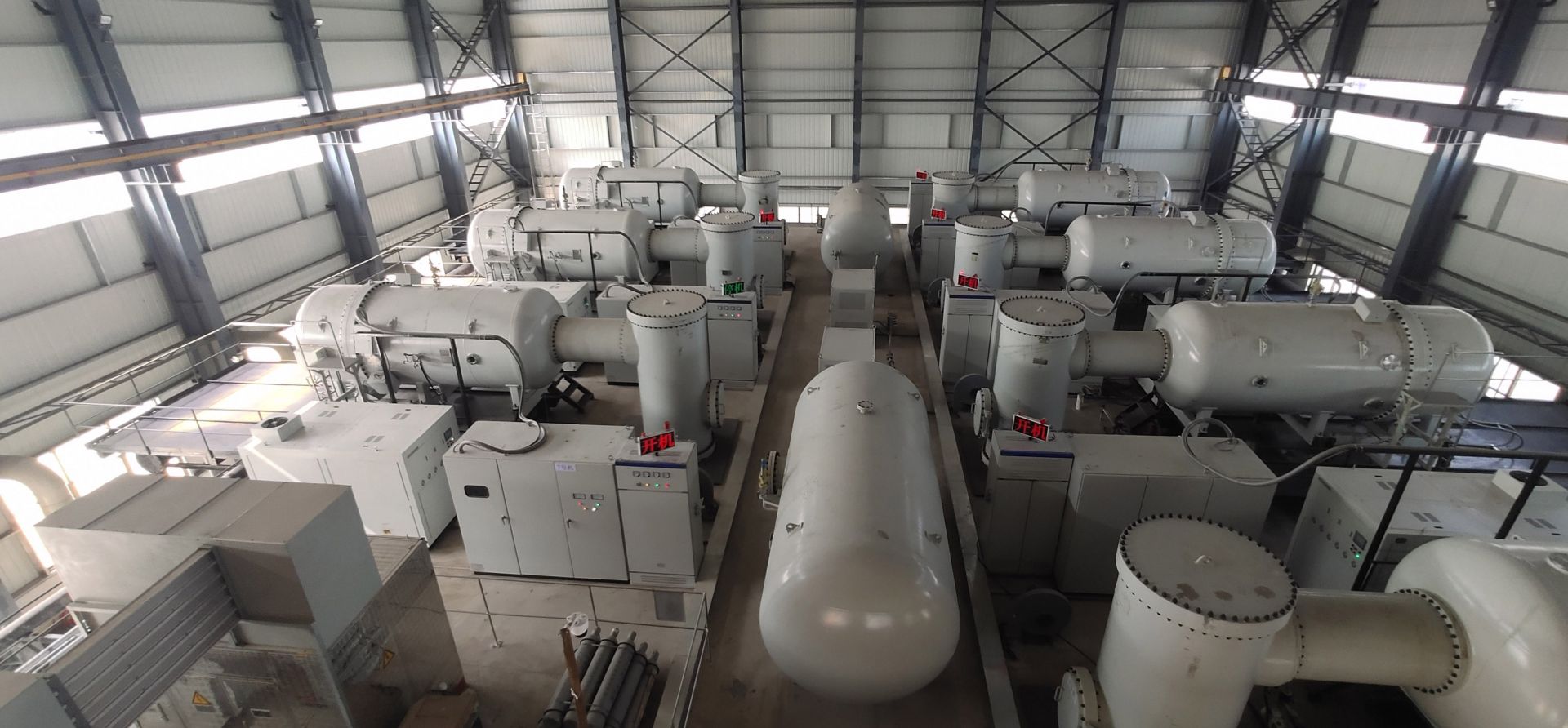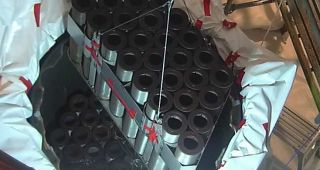July 16, 2021, 3:02PMNuclear NewsCarley Willis and Joanne Liou Photo: Institute of Nuclear and New Energy Technology
With the capacity to treat 30,000 cubic meters of wastewater per day, the largest industrial wastewater treatment facility using electron beam technology in the world was inaugurated in China in June 2020. The treatment process has the capacity to save 4.5 million m3 of fresh water annually—equivalent to the amount of water consumed by about 100,000 people.
Artistic rendering of the Hermes low-power demonstration reactor. (Image: Kairos Power)
Today, Tennessee governor Bill Lee joined Department of Economic and Community Development commissioner Bob Rolfe and Kairos Power officials in Nashville, Tenn., to celebrate Kairos’s plans to construct a low-power demonstration reactor in the East Tennessee Technology Park in Oak Ridge, Tenn. The company first announced its plans to redevelop the former K-33 gaseous diffusion plant site at the Heritage Center, a former Department of Energy site complex, in December 2020.
Taishan’s Unit 1 was the world’s first EPR to be connected to the grid. (Photo: CGN)
The facts, once known, were uncomplicated. At Taishan-1 in China—the first Framatome EPR to be commissioned—operators detected an increase of fission product gases within the primary coolant circuit sometime after the reactor’s first refueling outage in October 2020. The cladding on a handful of the more than 60,000 fuel rods in the reactor had been breached, posing an operational issue—but not a public safety issue—for the plant.
The DOE recently completed startup testing on the uninterruptable electrical power system for Hanford’s Low-Activity Waste Facility.
Department of Energy workers recently finished startup testing of a battery-powered backup electrical system for the Low-Activity Waste (LAW) Facility at the Hanford Site near Richland, Wash. According to the DOE’s Office of Environmental Management (EM), the uninterruptable electrical power system is vital to safeguarding the facility, part of Hanford’s Waste Treatment and Immobilization Plant, in the unlikely event of a temporary power loss to the plant.
An undated historical photo of a portion of the Hanford Site. (Photo: DOE)
The Department of Energy's Office of River Protection and the Richland Operations Office hosted a roundtable discussion recently with tribal nations located near the Hanford Site to review the Department’s tribal government policy—Order 144.1, the American Indian and Alaska Native Tribal Government Policy—and discuss opportunities for strengthening tribal consultation.
The Office of River Protection is within the purview of the DOE's Office of Environmental Management (EM). The Hanford Site, in eastern Washington state, is a 586-square-mile site that was used as a nuclear production complex during the World War II era.
Sequoyah nuclear power plant (Photo: Photorush/Wikimedia Commons)
In an evaluation report released last week on the Sequoyah nuclear plant’s chemistry/environmental program, the Tennessee Valley Authority’s Office of the Inspector General identified certain risks, both behavioral and operational, that could impact organizational effectiveness. Program behavior was assessed from interviews and field work conducted from September 21 through November 3, 2020, with operations assessed in February of this year.
Map of the PJM Interconnection territory in dark blue. Image: PJM
PJM Interconnection’s board of managers has approved the grid operator’s proposal to address the Federal Energy Regulatory Commission’s controversial December 2019 minimum offer price rule (MOPR) order affecting PJM’s forward-looking capacity auctions. (PJM operates the largest wholesale competitive electricity market in the country.)
Tuber magnatum, or European white truffles, may be the most expensive food on earth per kilogram. (Photo: Evan Sung)
Scientists from the Jozef Stefan Institute in Slovenia, with technical advice and analytical support from the International Atomic Energy Agency and the Food and Agriculture Organization of the United Nations, are studying the composition of truffles—a rare and expensive type of mushroom—in order to determine their origin and help detect fraud. Thanks to a database and the techniques developed, other laboratories worldwide can also test truffles, establish their geographical origin, and verify whether they are genuine.
The hemicycle of the European Parliament in Strasbourg. Photo by DAVID ILIFF.
Eighty-seven members of the European Parliament sent a letter to the European Commission last week to lobby for the addition of nuclear energy to the EU taxonomy, the purpose of which is to direct investments toward environmentally sustainable economic projects to meet the European Union’s climate change mitigation and energy-mix targets.
A look at Fukushima Daiichi today. (Photo: The Asahi Shimbun via Getty Images)
News programmers’ hunger for stories about the aftermath of the earthquake and subsequent tsunami that caused three reactor meltdowns at Fukushima Daiichi in March 2011 shows no signs of abating.
The Plutonium Facility at Los Alamos National Laboratory. (Photo: LANL)
The Defense Nuclear Facility Safety Board, which provides independent federal oversight of Department of Energy weapons facilities, has reported that low-level radioactive and other combustible waste is accumulating in the basement of Los Alamos National Laboratory’s Plutonium Facility (PF-4), and that housekeeping and waste management in the PF-4 basement have been a continuing challenge.
The 1958 Ford Nucleon concept car. (Photo: The Drive )
A car capable of traveling 5,000 miles between fueling stops? Sounds impossible, right? It turns out that, yes, it was impossible. But that didn’t stop the Ford Motor Company in 1958 from envisioning a car—the Nucleon—powered by a small nuclear reactor. The Drive took a close look at the fantastical idea in a July 5 article, “Inside the Impossible Dream of the Nuclear-Powered 1958 Ford Nucleon.”
Training for the realities of radiological incidents and emergencies
July 9, 2021, 2:43PMNuclear NewsGreg White, Steve Kreek, William Dunlop, Joshua Oakgrove, Dan Bower, Dave Trombino, Erik Swanberg, and Steven Pike One of the biggest challenges in training for incidents and emergencies that involve high-radiation-dose hazards is balancing between realism and safety. To be truly prepared for the realities of real-world nuclear and radiological emergencies, responder personnel need experience against those hazards but without introducing additional and very personal risks associated with unnecessary radiation exposure. The difficulty is in figuring out how we can achieve a level of realism that encompasses the entire process, from the initial detection of a hazard or threat, through its characterization, to recommending actions and leadership decision-making.





















